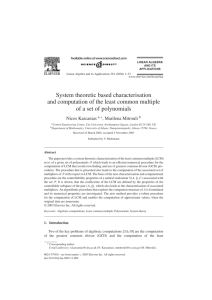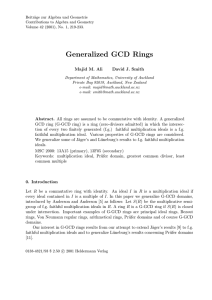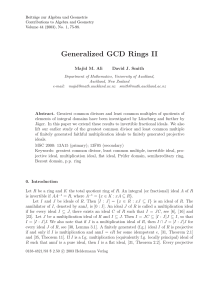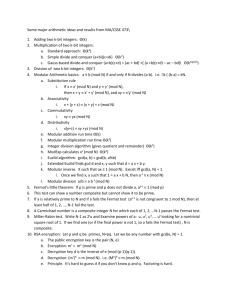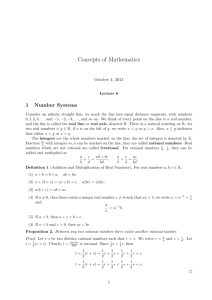On Some Functions Involving the lcm and gcd of Integer Tuples
advertisement
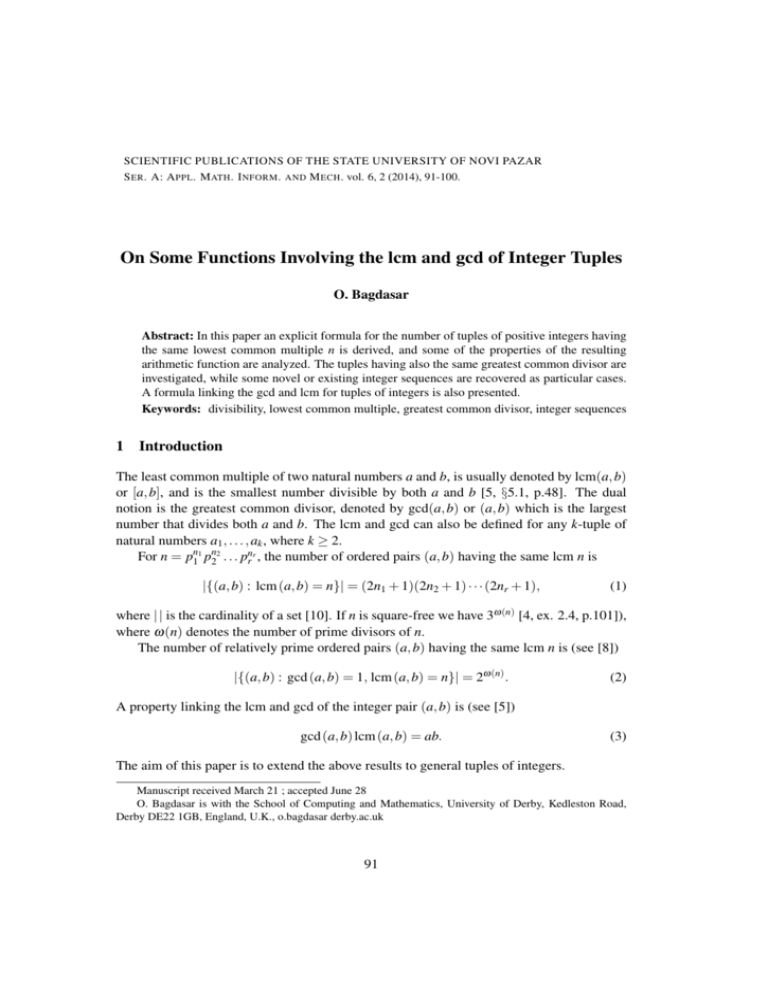
SCIENTIFIC PUBLICATIONS OF THE STATE UNIVERSITY OF NOVI PAZAR
S ER . A: A PPL . M ATH . I NFORM . AND M ECH . vol. 6, 2 (2014), 91-100.
On Some Functions Involving the lcm and gcd of Integer Tuples
O. Bagdasar
Abstract: In this paper an explicit formula for the number of tuples of positive integers having
the same lowest common multiple n is derived, and some of the properties of the resulting
arithmetic function are analyzed. The tuples having also the same greatest common divisor are
investigated, while some novel or existing integer sequences are recovered as particular cases.
A formula linking the gcd and lcm for tuples of integers is also presented.
Keywords: divisibility, lowest common multiple, greatest common divisor, integer sequences
1
Introduction
The least common multiple of two natural numbers a and b, is usually denoted by lcm(a, b)
or [a, b], and is the smallest number divisible by both a and b [5, §5.1, p.48]. The dual
notion is the greatest common divisor, denoted by gcd(a, b) or (a, b) which is the largest
number that divides both a and b. The lcm and gcd can also be defined for any k-tuple of
natural numbers a1 , . . . , ak , where k ≥ 2.
For n = pn11 pn22 . . . pnr r , the number of ordered pairs (a, b) having the same lcm n is
|{(a, b) : lcm (a, b) = n}| = (2n1 + 1)(2n2 + 1) · · · (2nr + 1),
(1)
where | | is the cardinality of a set [10]. If n is square-free we have 3ω (n) [4, ex. 2.4, p.101]),
where ω (n) denotes the number of prime divisors of n.
The number of relatively prime ordered pairs (a, b) having the same lcm n is (see [8])
|{(a, b) : gcd (a, b) = 1, lcm (a, b) = n}| = 2ω (n) .
(2)
A property linking the lcm and gcd of the integer pair (a, b) is (see [5])
gcd (a, b) lcm (a, b) = ab.
(3)
The aim of this paper is to extend the above results to general tuples of integers.
Manuscript received March 21 ; accepted June 28
O. Bagdasar is with the School of Computing and Mathematics, University of Derby, Kedleston Road,
Derby DE22 1GB, England, U.K., o.bagdasar derby.ac.uk
91
92
O. Bagdasar
The number of k-tuples of positive integers with the least common multiple n is
LCM(n; k) = |{(a1 , . . . , ak ) : lcm (a1 , . . . , ak ) = n}|,
(4)
and some identities and inequalities involving the above arithmetic function are presented.
A few sequences indexed in the On-Line Encyclopedia of Integer Sequences (OEIS) [7],
are obtained as particular cases.
The number of ordered k-tuples with the same gcd d and lcm n is defined by
GL(d, n; k) = |{(a1 , . . . , ak ) : gcd (a1 , . . . , ak ) = d, lcm (a1 , . . . , ak ) = n}|,
(5)
and a number of properties of this function are analyzed. In the process, some families of
integer sequences not currently indexed in the OEIS are produced.
Finally, a property linking the lcm and gcd for k-tuples of integers which generalizes
formula (3) is presented, accompanied by a brief proof based on [9].
2
Main results
In this section the proofs for the formulae of LCM and GL are provided, along with a result
linking the lcm and gcd computed for k-tuples of integers.
2.1
Tuples of integers with the same lcm
This section presents the formula for the number of ordered k-tuples whose least common
multiple is a natural number n. Some of the properties of this function are then investigated.
Theorem 2.1 Let k and n be naturals numbers. If n has the factorization n = pn11 pn22 . . . pnr r ,
the number of ordered k-tuples whose lcm is n is given by the formula
]
r [
LCM(n; k) = ∏ (ni + 1)k − nki .
(6)
i=1
Proof. Let {a1 , . . . , ak } be a k-tuple satisfying [a1 , . . . , ak ] = n. The numbers a1 , . . . , ak
need to be divisors of n, therefore they can be factorized as
a
a
a
a j = p11 j · p22 j . . . · pr r j ,
j = 1, . . . , k,
(7)
with 0 ≤ ai j ≤ ni (i = 1, . . . , r). Because their lcm is n, one needs to have
max{ai1 , . . . , aik } = ni ,
(8)
for each divisor pi , i = 1, . . . , r.
For each i ∈ {1, . . . , r}, the total number of pairs 0 ≤ ai j ≤ ni ( j = 1, . . . , k) is (ni + 1)k .
On the other hand, the number of ordered pairs 0 ≤ ai j ≤ ni − 1 ( j = 1, . . . , k) not having ni
as a maximum is nki . The number of pairs satisfying relation (8) is therefore (ni + 1)k − nki .
Multiplying this formula for i = 1, . . . , r one obtains (6).
93
On some functions involving the lcm and gcd of integer k-tuples
Remark 2.1 For particular values of k, one recovers the following OEIS indexed integer
sequences: A048691 for LCM(n; 2) (linked to numerous algebraic interpretations), and
A070919, A070920, A070921 for LCM(n; 3), LCM(n; 4), LCM(n; 5), respectively.
The following result illustrates the independence of LCM(n; k) on the prime factors.
Corollary 2.1 Let k be a natural number and n = pn11 pn22 . . . pnr r , m = qn11 qn22 . . . qnr r , such
that all numbers p1 , . . . , pr , q1 , . . . , qr are distinct. Then LCM(m; k) = LCM(n; k).
Proof. From (6), LCM(n; k) only depends on the multiplicities of the prime factors, and not
on the prime factors themselves. In this case
]
r [
LCM(m; k) = ∏ (ni + 1)k − nki = LCM(n; k)
i=1
Considering relatively prime numbers m and n, one obtains the consequence below,
which here is proved using a direct method.
Corollary 2.2 Let m, n be integers satisfying (m, n) = 1. The following property holds
LCM(m · n; k) = LCM(m; k) · LCM(n; k).
(9)
n1 n2
ms
nr
1 m2
Proof. Consider the following factorizations of m = qm
1 q2 . . . qs and n = p1 p2 . . . pr .
As (m, n) = 1, it follows that pi ̸= q j , for any combination of i = 1, . . . , r and j = 1, . . . , s.
This implies that the prime factorization of the product mn is
n1 n2
ms
nr
1 m2
m · n = qm
1 q2 · · · qs · p1 p2 · · · pr ,
with the prime factors not necessarily in an increasing order. By formula (6) one obtains
] s [
]
r [
LCM(m · n; k) = ∏ (mi + 1)k − mki · ∏ (n j + 1)k − nkj = LCM(m; k) · LCM(n; k),
i=1
j=1
which ends the proof.
Here are recalled some well known properties of arithmetic functions [1, Chapter 2].
An arithmetic function f (n) of the positive integer n is multiplicative if f (1) = 1 and for
any a and b coprime, then f (ab) = f (a) f (b). An arithmetic function is said completely
multiplicative if f (1) = 1 and f (ab) = f (a) f (b), even when a and b are not coprime.
Remark 2.2 From Corollary 2.2, the function LCM(n; k) is multiplicative.
Remark 2.3 Let a, b be positive integers and f : N → N be a multiplicative arithmetic
function. The following property holds
f (gcd(a, b)) · f (lcm(a, b)) = f (a) · f (b) .
(10)
Proof. Let d = gcd(a, b). The numbers d, a/d and b/d are coprime. Using (3) one obtains
f (d) f (lcm(a, b)) = f (d) [ f (d) f (a/d) f (b/d)] = [ f (d) f (a/d)] [ f (d) f (b/d)] = f (a) f (b) .
This ends the proof.
94
O. Bagdasar
For LCM(n; k) we can check directly the property relative to lcm and gcd.
Corollary 2.3 Let a, b be natural numbers. The following property holds:
LCM (gcd(a, b); k) · LCM (lcm(a, b); k) = LCM (a; k) · LCM (b; k) .
pn11 pn22 . . . pnr r ,
(11)
pd11 pd22 . . . pdr s
Proof. Assume that the factorizations of n, d, a, b are n =
d=
β
β
β
α1 α2
r
1
2
α
and a = p1 p2 . . . pr r , b = p1 p2 . . . pr , where some of the powers may be zero. Using
the relation (6), it is sufficient to prove the formula for just one fixed value i from 1, . . . , r.
The contribution of the prime factor pi to formula (11) is
[
] [
] [
] [
]
(ni + 1)k − nki · (di + 1)k − dik = (αi + 1)k − αik · (βi + 1)k − βik
This relation is true, as di = min{αi , βi } and ni = max{αi , βi }.
Some inequalities for LCM(n; k) can also be proved, for general values of m and n.
Theorem 2.2 Let k, m and n be natural numbers. The following inequality holds
LCM(m · n; k) ≤ LCM(m; k) · LCM(n; k)
(12)
To prove this theorem, we shall first prove the following result.
Lemma 2.3 Let k ≥ 2, p be a prime number and α , β ≥ 1 natural numbers. Then
LCM(pα +β ; k) ≤ LCM(pα ; k) · LCM(pβ ; k)
(13)
Proof. The inequality (13) is then equivalent to
] [
]
[
] [
(14)
(α + β + 1)k − (α + β )k ≤ (α + 1)k − α k · (β + 1)k − β k .
(k )
l then
From (6) we have LCM(pα +β ; k) = (α + β + 1)k − (α + β )k = ∑k−1
l=0 l (α + β ) (, )
(
)
k
k−1 k
i
β
k
k
j
LCM(pα ; k) = (α + 1)k − α k = ∑k−1
i=0 i α and LCM(p ; k) = (β + 1) − β = ∑ j=0 j β .
i j
For a fixed pair (i, j) with i, j chosen from(the
)( set
) {0, . . . , k − 1}, the term α β i appears
k k
in the right-hand side, and its coefficient is i j . On the other hand, the term α β j only
( )( )
appears on the left-hand side if l = i + j ≤ k − 1, and its coefficient is kl li .
To finalize the proof it remains to be shown that the latter coefficient is smaller than the
former. One can check that
(k)(k)
k(k − 1) · · · (k − i + 1)
i j
≤ 1.
(k)(l ) =
(k
−
j)(k
−
j
−
1)
·
·
·
(k
−
j
−
i
+
1)
l i
The computational details of the proof are left to the reader as an exercise.
mr and n = pn1 pn2 . . . pnr , where m , n ≥ 0.
1 m2
Consider the factorizations of m = pm
p
.
.
.
p
i i
r
r
1
2
1 2
Using Corollary 2.2 for the prime factors p1 , . . . , pr and their powers, and Lemma 2.3 for
each of the indices i = 1, . . . , r, one obtains (12). This ends the proof of the theorem.
Remark 2.4 It is not difficult to prove that using particular values that the inequality in
Theorem 2.2 is strict for k ≥ 2. For example, for p = 2, α = β = 1 one obtains the relation
3k − 2k < (2k − 1k )(2k − 1k ), which is true for all values k ≥ 2. This also proves that
LCM(n; k) is not completely multiplicative.
95
On some functions involving the lcm and gcd of integer k-tuples
2.2 Tuples of integers with the same lcm and gcd
This section evaluates the function GL(d, n; k) given by (5), enumerating the k-tuples with
fixed greatest common divisor d and least common multiple n. Some of its properties and
particular instances are also presented, along with some novel number sequences.
The following lemma represents the motivation for the results in this section.
Lemma 2.4 Let d < n be positive integers, such that d|n. The number of ordered pairs
(a, b) with the same greatest common divisor d and least common multiple n is
|{(a, b) : gcd (a, b) = d, lcm (a, b) = n}| = 2ω (n/d) .
(15)
where ω (x) represents the number of distinct prime divisors for the integer x.
Proof. Let the numbers d, n, a, b have the prime decompositions
d = pd11 pd22 · · · pdr r ,
n = pn11 pn22 · · · pnr r ,
a = pα1 1 pα2 2 · · · pαr r ,
β
β
b = p1 1 p2 2 · · · pβr r ,
where 1 ≤ di ≤ ni for i = 1, . . . , r.
As d = (a, b) and n = [a, b], di = min{αi , βi } and ni = max{αi , βi } for each i ∈ {1, . . . , r}.
Also, the numbers a and b are distinct, or otherwise d = n. There are two possibilities.
When di = ni , one has αi = βi = di = ni . Each choice of i ∈ I = {i ∈ {1, . . . , n} : di < ni }
generates two possible pairs (αi , βi ) ∈ {(di , ni ), (ni , di )}, hence in total there are 2|I| distinct
pairs of powers. As the prime decomposition of n/d is
n/d = pn11 −d1 pn22 −d2 · · · pnr r −dr = ∏ pni i −di ,
i∈I
one obtains that |I| = ω (n/d). This ends the proof. For d = 1 one recovers the result (2),
representing the number of unitary divisors, indexed as A034444 in the OEIS.
The following result relates GL(d, n; k) to the set of relatively prime tuples, and shows
that finding GL(d, n; k) can be reduced to evaluating GL(1, n/d; k).
Lemma 2.5 Let k and d|n be natural numbers. If d = pd11 pd22 . . . pdr r and n = pn11 pn22 . . . pnr r ,
the number of ordered k-tuples whose gcd is d, and lcm is n satisfies the property
GL(d, n; k) = GL(1, n/d; k).
(16)
Proof. Let {a1 , . . . , ak } be a k-tuple satisfying (a1 , . . . , ak ) = d and [a1 , . . . , ak ] = n. Numbers a1 , . . . , ak are multiples of d and divisors of n, therefore they can be factorized as
a
a
a
a j = p11 j · p22 j . . . · pr r j ,
j = 1, . . . , k,
with di ≤ ai j ≤ ni (i = 1, . . . , r). Because their gcd is d and lcm is n, one needs to have
min{ai1 , . . . , aik } = di ,
max{ai1 , . . . , aik } = ni ,
(17)
96
O. Bagdasar
for each pi , i = 1, . . . , r. The number of tuples in (17) is the same as of the tuples satisfying
min{a′i1 , . . . , a′ik } = 0,
max{a′i1 , . . . , a′ik } = ni − di ,
which relate to the k-tuples having the properties (a′1 , . . . , a′k ) = 1 and [a′1 , . . . , a′k ] = n/d.
This ends the proof.
Lemma 2.6 Let k and α be positive integers. The number of tuples (α1 , . . . , αk ) satisfying
T(α ; k) = |{(α1 , . . . , αk ) : min (α1 , . . . , αk ) = 0, max (α1 , . . . , αk ) = α }|
(18)
is given by the formula
T(α ; k) = (α + 1)k − 2α k + (α − 1)k .
(19)
Proof. Consider the term T(α ; k +1) representing the number of (k +1)-tuples (α1 , . . . , αk+1 )
whose min is 0 and max is α . There are three distinct cases, depending on the value of αk+1 .
1. αk+1 = 0. In this case the k-tuple (α1 , . . . , αk ) has to satisfy max(α1 , . . . , αk ) = α .
Following the argument used in Theorem 2.1, the number of k-tuples having this
property is (α + 1)k − α k .
2. αk+1 = n. Here the restriction on the k-tuple (α1 , . . . , αk ) is min(α1 , . . . , αk ) = 0.
Similarly as above, the number of k-tuples with this property is (α + 1)k − α k .
3. 0 < αk+1 < n. For each of the (α −1) possible values of αk+1 , the k-tuples (α1 , . . . , αk )
satisfy min(α1 , . . . , αk ) = 0 and max(α1 , . . . , αk ) = α , and their number is T(α ; k).
By counting all the (k + 1)-tuples for a fixed α , the terms T(α ; k) satisfy the recurrence
]
[
T(α ; k + 1) = 2 (α + 1)k − α k + (α − 1)T(α ; k)
(20)
For α ≥ 1 one has T(α ; 0) = T(α ; 1) = 0, while from the proof of Lemma 2.5, T(α ; 2) = 2.
Writing the recursion until T(α ; 1), one obtains
]
[
k
T(α ; k + 1) = 2 ∑ (α − 1)i (α + 1)k−i − α k−i + (α − 1)k+1 T (α ; 0)
i=0
k [
= 2 ∑ (α − 1)i (α + 1)k−i − (α − 1)i α k−i
]
i=0
[
(α + 1)k+1 − α k+1 α k+1 − (α − 1)k+1
= 2
−
2
1
]
= (α + 1)k+1 − 2α k+1 + (α − 1)k+1 ,
(
)
where the relation ak+1 − bk+1 = (a − b) ak + ak−1 b + · · · + abk−1 + bk valid for any a, b
was used. The result proves (19), which could also be checked by mathematical induction.
Here the direct proof was preferred, as it shows how the formula can be derived.
97
On some functions involving the lcm and gcd of integer k-tuples
For a simplified notation we may define L(n; k) := GL(1, n; k), for positive integers k, n.
The formula for L(n; k) now follows as a direct consequence of Lemma 2.6.
Theorem 2.7 Let k and n be naturals numbers. If n has the factorization n = pn11 pn22 . . . pnr r ,
the number of ordered k-tuples whose gcd is 1 and lcm is n, is given by the formula
]
r [
L(n; k) = ∏ (ni + 1)k − 2nki + (ni − 1)k .
(21)
i=1
Proof. Let {a1 , . . . , ak } be a k-tuple satisfying gcd(a1 , . . . , ak ) = 1 and lcm[a1 , . . . , ak ] = n.
The numbers a1 , . . . , ak can be factorized as
a
a
a
a j = p11 j · p22 j . . . · pr r j ,
j = 1, . . . , k,
with 0 ≤ ai j ≤ ni (i = 1, . . . , r). Because their gcd is 1 and lcm is n, one needs to have
min{ai1 , . . . , aik } = 0,
max{ai1 , . . . , aik } = ni ,
for each pi , i = 1, . . . , r, which from Lemma 2.6 produces (ni + 1)k − 2nki + (ni − 1)k tuples.
By taking the product over all factors pi , i = 1, . . . , r one obtains (21).
The following properties of L(n; k) are direct consequences of formula (21), similar to
the results obtained for LCM(n; k). For this reason these are presented here without proofs.
The first property suggests the exclusive dependence of L(n; k) on the prime factorization.
Corollary 2.4 Let k be a natural number and n = pn11 pn22 . . . pnr r , m = qn11 qn22 . . . qnr r , such
that all numbers p1 , . . . , pr , q1 , . . . , qr are distinct. Then L(m; k) = L(n; k).
The following results states the multiplicity of the arithmetic function L(n; k) for k ≥ 2.
Corollary 2.5 Let m, n be comprime integers and k ≥ 2. The following property holds
L(m · n; k) = L(m; k) · L(n; k).
(22)
The last result is a consequence of the multiplicity.
Corollary 2.6 Let a, b be natural numbers. The following property holds:
L (gcd(a, b); k) · L (lcm(a, b); k) = L (a; k) · L (b; k) .
(23)
Remark 2.5 Choosing m = n = 2 and k ≥ 2 one may check that
L(m · n; k) = 3k − 2 · 2k + 1 < (2k − 2) · (2k − 2) = L(m; k) · L(n; k).
This proves that L(n; k) is not completely multiplicative.
Preliminary investigations suggest that the inequality L(m · n; k) ≤ L(m; k) · L(n; k) is true.
However, a complete solution is not known to the author.
98
2.3
O. Bagdasar
Integer sequences related to T(n; k) and L(n; k)
A number of integer sequences can be obtained from T(n; k), for particular values of k and n.
These novel, or existing OEIS number sequences have a unified interpretation, representing
the number of ordered k-tuples whose minimum is zero and maximum is n.
For n = 1, one obtains T(1; k) = 2k −2, which is the number of nonempty proper subsets
for a set with k elements, indexed as A000918 in the OEIS. For n = 2, the sequence defined
by T(2; k − 1) = 3k−1 − 2k + 1, represents the Stirling numbers of the second kind, indexed
as A028243 in the OEIS. The first few terms of the sequences T(n; k) for n = 3, 4, 5 give
T(3; k) :
0, 2, 18, 110, 570, 2702, 12138, 52670, 223290, 931502, . . .
(24)
T(4; k) :
0, 2, 24, 194, 1320, 8162, 47544, 266114, 1448520, 7727522, . . .
(25)
T(5; k) :
0, 2, 30, 302, 2550, 19502, 140070, 963902, 6433590, 41983502, . . . (26)
not currently indexed in the OEIS, suggesting that they are probably new number sequences.
For k = 1, 2, 3, one obtains T(n; 1) = 0, T(n; 2) = 2 and T(n; 1) = 3n, respectively. For
k = 4, the sequence defined by T(n; 4) = 12n2 + 2, represents the number of points on
surface of hexagonal prism, indexed as A005914 in the OEIS. Finally, for k = 5 one obtains
T(n; 5) = 20n3 + 10n, which is A068236 (also, T(n + 1; 5) produces A101098).
Several integer sequences are obtained from L(n; k), for particular values of k and n.
Some special cases worth mentioning. For a prime number p, one has L(p; k) = 2k − 2.
Also, the values L(n; 1) = 0 and L(1; k) = 1 are produced, for a positive integer n and k ≥ 2.
If n = pn11 pn22 . . . pnr r , the following results are obtained as particular cases:
]
r [
L(n; 2) = ∏ (ni + 1)2 − 2n2i + (ni − 1)2 = 2ω (n) ,
(27)
i=1
r [
L(n; 3) =
∏
]
r
(ni + 1)3 − 2n3i + (ni − 1)3 = 6ω (n) ∏ ni ,
(28)
∏
]
]
(ni + 1)4 − 2n4i + (ni − 1)4 = 2ω (n) ∏ 6n2i + 1 ,
(29)
∏
]
(ni + 1)5 − 2n5i + (ni − 1)5 = 10
i=1
r [
L(n; 4) =
i=1
r [
L(n; 5) =
i=1
i=1
r [
i=1
r
ω (n)
∏
[ 3
]
2ni + ni .
(30)
i=1
For some particular values of k, a number of novel integer sequences can be recovered.
For k = 2, one obtains L(n; 2) = 2ω (n) , which is as seen before, is A034444 in the OEIS.
The first few terms of the number sequences L(n; k) for k = 3, 4, 5 give
L(n; 3) :
1, 6, 6, 12, 6, 36, 6, 18, 12, 36, 6, 72, 6, 36, 36, . . .
(31)
L(n; 4) :
1, 14, 14, 50, 14, 196, 14, 110, 50, 196, 14, 700, 14, 196, 196, . . .
(32)
L(n; 5) :
1, 30, 30, 180, 30, 900, 30, 570, 180, 900, 30, 5400, 30, 900, 900, . . . (33)
not currently indexed in the OEIS.
The enumeration of results in this section suggests that some of the sequences presented
are new. Also, some existing sequences were given a different interpretation.
On some functions involving the lcm and gcd of integer k-tuples
99
2.4 A link between the lcm and gcd of k-tuples of integers
One can use the prime number factorization to prove the following relations, which link the
lcm and gcd of k-tuples of integers. Detailed proofs can be found in [9].
Theorem 2.8 Let k ≤ 2 and a1 , . . . , ak be natural numbers. The following property holds
lcm (a1 , a2 , . . . , ak ) =
∏
gcd (ai1 , . . . , aiu )
∏
gcd (ai1 , . . . , aiv )
1≤i1 <...<iu ≤k
1≤i1 <...<iv ≤k
,
(34)
where u is odd and v is even.
The dual of this theorem can be written as
Theorem 2.9 Let k ≤ 2 and a1 , . . . , ak be natural numbers. The following property holds
gcd (a1 , a2 , . . . , ak ) =
∏
lcm (ai1 , . . . , aiu )
∏
lcm (ai1 , . . . , aiv )
1≤i1 <...<iu ≤k
1≤i1 <...<iv ≤k
,
(35)
where u is odd and v is even.
Sketch of proof: Assuming that the multiplicities of p in a1 , . . . , ak are m1 , . . . , mk , the
problem of proving (34) can be reduced to proving the identity below.
max(m1 , . . . , mk ) =
∑
1≤i1 <...<iu ≤n
min(mi1 , . . . , miu ) −
∑
1≤i1 <...<iv ≤n
min(mi1 , . . . , miv ),
(36)
where u is odd and v is even.
3
Discussion
The research originated in the counting problem solved by the authors in [2]. There, the
Horadam sequences with a fixed period were enumerated using a formula involving all the
pairs of numbers having the same lcm, given by formula (1).
In this paper an explicit formula for the number of integer k-tuples with the same lcm
n denoted by LCM(n; k), was established. Some properties of this arithmetic function were
explored, being shown that LCM(n; k) is multiplicative, but not completely multiplicative.
The general formula plays a key role in the enumeration of generalized periodic Horadam
sequences, characterized in [3]. The integer sequences LCM(n; 2), LCM(n; 3), LCM(n; 4)
and LCM(n; 5) were found to be indexed in the OEIS.
The function GL(d, n; k) counting the k-tuples with same gcd d and lcm n was defined.
Most of the properties were linked to the arithmetic function L(n; k) := GL(1, n; k), whose
formula was given. Function L(n; k) was multiplicative, but not completely multiplicative.
Function T(n; k), enumerating k-tuples whose min is zero and max is n was also analyzed.
Novel, or existing OEIS integer sequences were produced from T(n; k) and L(n; k).
Finally, two dual properties linking the gcd and lcm of k-tuples were presented.
100
O. Bagdasar
References
[1] T. M. A POSTOL, Introduction to Analytic Number Theory, Springer, New York, 1976.
[2] O. BAGDASAR and P. J. L ARCOMBE, On the number of complex Horadam sequences with
a fixed period, Fibonacci Quart., Vol. 51, 4 (2013), 339–347.
[3] O. Bagdasar and P. J. Larcombe, On the characterization of periodic generalized Horadam
sequences, J. Differ. Equ. Appl. (accepted).
[4] R. C RANDALL and C. P OMERANCE,
Springer, New York, 2001.
Prime Numbers: A Computational Perspective,
[5] G. H. H ARDY and E. M. W RIGHT An Introduction to the Theory of Numbers, Oxford
University Press, Oxford, Fifth edition, 1979.
[6] Octogon Mathematical Magazine, Collection, 1993–2012.
[7] The On-Line Encyclopedia of Integer Sequences, http://oeis.org, OEIS Foundation Inc. 2011.
[8] R. R. S ITARAMACHANDRA and D. S URYANABAYANA, The number of pairs of integers
with L.C.M. ≤ x, ARCH. MATH., Vol XXI (1970), 490–497.
[9] D. V ĂLCAN and O. D. BAGDASAR, Generalizations of some divisibility relations in N,
Creative Math. & Inf., Vol. 18, 1 (2009), 92–99.
[10] F. Z UMHING and T. A NDREESCU,
Birkhauser, 2004.
A Path To Combinatorics for Undergraduates,

